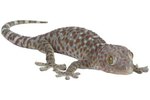
Many differences exist among the reptile family; some have legs, for example, while others prefer to slither instead of walk. They also lay different types of eggs. Most reptiles lay eggs with soft, leathery shells, but a few have eggs with a hard exterior, similar to those of bird eggs.
Hard-Shelled Varieties
There doesn't seem to be much logic behind which reptiles lay hard eggs and which ones deposit soft ones. Even very similar species might lay different types of eggs. Most turtles, for example, lay leathery eggs, but a few lay hard eggs, such as stinkpots and mud turtles. Many tortoises lay hard eggs, as do geckos. Crocodiles deposit hard eggs as well. These reptiles leave their eggs in a nest, usually buried under sand or soil, without parental involvement, although crocodiles might hang around to protect the eggs and hatchlings.
On the Softer Side
Turtles who lay the softer, leathery eggs tend to be the aquatic varieties. They return to land to dig nests and lay eggs, then they bury the eggs and return to the water. Most lizard and snake species lay leathery eggs as well, although some snakes give live birth or carry the eggs inside their bodies until the eggs hatch. The leathery exterior helps hold in moisture and protect the babies while remaining slightly flexible.
What's the Difference?
The main reason some eggs are hard is that they contain more calcium than the softer eggs. The moms transfer calcium from their bodies to the eggs, and many seek out a high-calcium diet as they prepare to lay eggs. Without the proper diet, the egg development can leach calcium from other areas of the mother, such as her blood and bones.
Getting Out Free and Clear
Reptile hatchlings typically develop a special tool to help them escape their eggs: an egg tooth. Some reptiles grow an extra tooth in the front of their mouths that points forward. This tooth usually develops on reptiles who need to rip and tear through leathery shells, which requires a sharp point and strong shaft. Those in hard shells often grow a hard, short knob on the ends of their noses or lips. They knock on the inside of the shell with the knob until the shell cracks, then they push their way out with their snouts and front legs.
References
Photo Credits
-
Anup Shah/Photodisc/Getty Images




